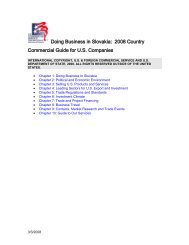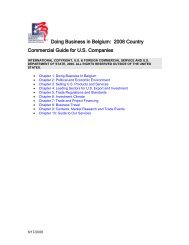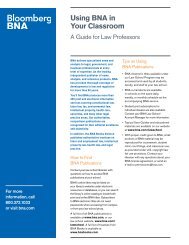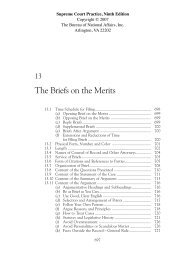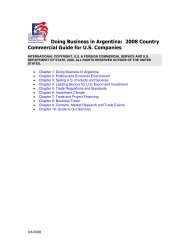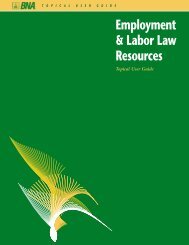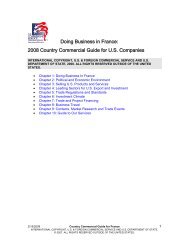Doing Business In Saudi Arabia - Bna
Doing Business In Saudi Arabia - Bna
Doing Business In Saudi Arabia - Bna
Create successful ePaper yourself
Turn your PDF publications into a flip-book with our unique Google optimized e-Paper software.
Automotive Parts & Service Equipment (APS)<br />
Overview Return to top<br />
<strong>Saudi</strong> <strong>Arabia</strong> is the largest country in the Middle East in terms of population and has the<br />
largest overall vehicle market. The strength of <strong>Saudi</strong> Economy and continued population<br />
growth in recent years led to 4% yearly growth in the number of all types of vehicles<br />
imported into the Kingdom of <strong>Saudi</strong> <strong>Arabia</strong>. Every household has on an average, 1<br />
passenger vehicle. This is true across urban, provincial, and rural <strong>Saudi</strong> <strong>Arabia</strong>. Sedans<br />
are the most popular passenger vehicles (75%) followed by 4 wheel drive (4X4s)<br />
vehicles (20%) with ownership of 4X4s higher in rural areas (27% own a 4X4). The<br />
average age of vehicles is 6.4 years with 42% of vehicles manufactured in 2001 or later.<br />
Larger local households own American brands, while relatively smaller local households<br />
buy European brands. People with lower education levels and incomes buy Korean<br />
brands. Over the years, U.S. manufacturers have witnessed their market share steadily<br />
eroding to Japanese and South Korean car manufacturers, especially Japanese<br />
companies, which have consistently enhanced their share of the <strong>Saudi</strong> automotive<br />
market, especially for passenger cars. New vehicles - Japanese brands account for twothirds<br />
of the new vehicle market, Toyota alone has a 40 percent market share.<br />
American brands account for less than a third of the market. Korean brands have been<br />
growing over time, while the share of European brands has been declining. Dammam is<br />
the only place where American brands close the gap with Japanese brands. More than<br />
340,000 cars, trucks and vans are annually imported into <strong>Saudi</strong> <strong>Arabia</strong>, including used<br />
cars and buses.<br />
The economic recovery, which started a few years ago, will likely boost the demand to<br />
around 360,000 units, valued at $6.3 billion. A higher per capita income, currently at<br />
$13,000, will further enhance the demand for new cars and vans. The higher value of<br />
the Euro and the Yen against the U.S. Dollar has little effect on the share of European<br />
and Japanese car sales, which control nearly 70 percent of the market. Japan, the U.S.,<br />
Australia, Germany, and South Korea are the key players in the <strong>Saudi</strong> automotive<br />
market representing more than 90 percent of all vehicle imports.<br />
Brands Bought New Year Of Manufacture<br />
% % % % %<br />
Japanese 58.0 63.7 55.9 61.8 62.5<br />
American 38.1 28.8 34.7 30.3 29.5<br />
European 5.6 4.7 7.0 6.3 6.2<br />
Korean 0.5 3.1 3.7 5.4 8.5<br />
China 0.20 2.5 3.2 4.5 8.0<br />
Used Cars Market<br />
<strong>Saudi</strong> <strong>Arabia</strong> has a large secondhand market. The market for second-hand vehicles is<br />
largely sourced from the United States and to a lesser extent from Germany. Demand<br />
for second-hand vehicles has been shrinking annually by an average four percent due to<br />
5/13/2008



